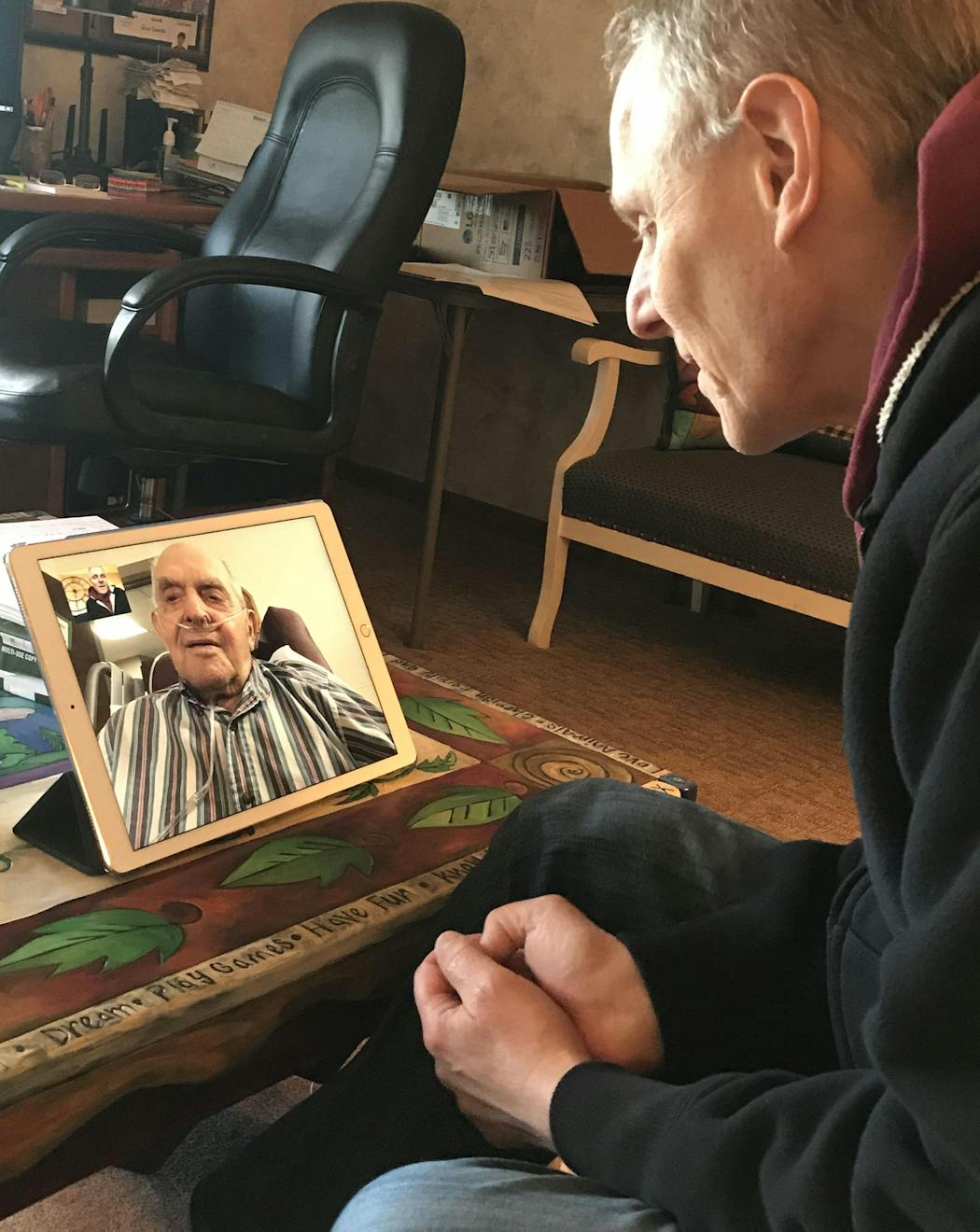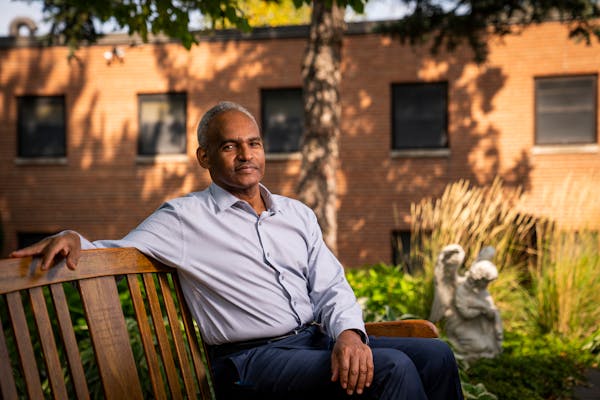Throughout his career, when physician Allan Kind signed medical records, he wrote "A Kind, MD."
"A nurse told me, that described him exactly," said Betsy, his wife of 54 years. "A kind MD."
An infectious disease specialist, Dr. Kind was credited with saving many patients' lives by overseeing aggressive treatment. But in April, one year after his own diagnosis of pancreatic cancer, Kind and his medical team decided it was time to stop his chemotherapy and concentrate instead on managing his pain.
It was time to let go.
It was time to bring in hospice.
"Hospice was a gift to us. The staff was so well-versed in how to care for someone at this stage of life," Betsy said. "They noticed when Allan's decline accelerated and this was an important observation. They said it was time for his goodbyes."
Lying in a hospital bed in his Minnetonka living room, Kind saw his masked daughter and 15-year-old granddaughter. The next day his son and 9-year-old twin granddaughters visited.
"They kept their distance but came over to touch his hand before they left," Betsy recalled. "He was hospitalized at the first of the year, then COVID[-19] started so he hadn't seen them since January. They needed these last loving moments."
In subsequent days, a few longtime colleagues stopped by to pay a poignant farewell.
"They were able to say what working together all those years had meant to them. That was comforting. In spite of the restrictions, we all felt good about it."
One week after his team at Park Nicollet Methodist Hospice warned that death was imminent, Allen slipped into unconsciousness. Betsy noticed that his breathing changed, just as a hospice nurse had told her it would. She knew what to do.
"I didn't call 911, no one had to come. I could touch him, hold him, tell him how much I love him. I don't know if he heard but I was there," she said. "The ending was exactly right. He was prepared, where he wanted to be. He was calm and at peace. We had no regrets."
A 'humane' alternative
Hospice care has dramatically changed the end of life for thousands of Minnesotans and their families. Although restrictions brought on by the coronavirus have complicated the approach, it remains a valued choice.
"Patients can access their hospice Medicare benefits when their doctors determine they have six months or less to live," explained Jessica Hausauer, executive director of the Minnesota Network of Hospice & Palliative Care.
In hospice, care shifts from treating and curing illness and disease to emphasizing a patient's comfort and emotional and spiritual needs. Care is typically provided by an interdisciplinary team of experts including doctors, nurses, social workers and chaplains. Hospice regards family and caregivers as part of the care team; the needs of grieving family members are also addressed.
"Hospice realizes it's not always a humane choice, to extend life at all costs," Hausauer said. "In hospice we ask, what are your goals, what matters most, what is the right path for you."
Minnesota's hospice movement started in the 1980s, first as a volunteer effort led by a small group of innovators, often nurses. Today Minnesota is home to an estimated 150 hospices that provide the service in homes, hospitals, assisted living facilities, nursing homes and stand-alone inpatient centers.
Hospice became a Medicare-covered benefit in 1983, allowing the federal government to track it. Minnesota ranks 11th in the nation in the number of Medicare patients who choose the option. According to the MNHPC, an estimated 19,000 Minnesotans die in hospice every year; 53% of the state's Medicare decedents utilized hospice services at the time of their death.
'Profound, sacred experience'
As her death neared, Rosaire Hall offered a bit of advice to her children, grandchildren and great-grandchildren.
"She said, go enjoy this beautiful life," said her granddaughter Heather Kern. "She certainly did that; she was a unique individual who achieved a lot in her 87 years."
Hall spent the first part of her adulthood in a religious order. A Roman Catholic nun, she earned advanced degrees and became a school principal and Mother Superior. She left the convent after 25 years and ultimately married a St. Cloud businessman, adopted his four children and became an English professor at St. Cloud State University, also teaching at the state prison there.
But it wasn't those accomplishments that endeared her to her family.
"We spent summers at the lake with her and she was spontaneous, our fun grandma," Kern recalled. "So many happy memories."
After an August diagnosis of multiple myeloma, Hall had to leave her home near Grand Rapids, Minn., to be cared for in a nursing home there.
"The disease took off fast and we knew we didn't have long with her. Because of COVID, we couldn't visit. She deserved better than that," said Kern.
So the family made the decision to transfer Hall closer to them, settling her at Quiet Oaks Hospice House in St. Cloud. With restrictions in place, two masked family members at a time could sit with her, taking turns at her bedside during limited visiting hours.
"The goal was to keep her alert enough to have quality time up to the end; she wasn't too drugged up but she wasn't in pain," Kern said. "We talked about old times, reminisced, looked at pictures. She loved all that. She was comfortable with her faith. She wasn't afraid."
After Hall died in her sleep, her hospice team arranged for her family to be present with her one last time.
"I sat with her after she passed away. I heard the wind chimes on the porch and it was her spirit saying she was OK," Kern said. "I feel her around me all the time. We walked that last mile with her."
Being present for a loved one's death in hospice is an experience that most people have only a few times in their lives, but Angela Woosley has spent many hours attending the dying in a hospice environment.
Trained as a mortician, Woosley now works as an end-of-life doula and helps families coordinate vigils and personalized rituals before, during and after death.
"There's power and value spending time with the dying and the dead. It helps you understand the reality of that loss as you start the grief journey in a world where that person isn't any more," she said. "Even a moment can be a profound and sacred experience."
Woosley believes the hospice option has changed the American expectation about the end of life and reframed it so that dying is not viewed as creepy or gruesome, but as a transition that is gentle, natural, even beautiful.
"Hospice has increased our exposure to good death. Instead of fighting against it, we're having these wonderful conversations about what it is, how can it be achieved," she said.
"Facing and embracing mortality shows you how to live your life with agency and passion. Our days on earth are finite. Reconciling your eventual death is a way to live a fuller life."
Medical specialists
Health care professionals spend years learning how to extend life, using new and heroic measures to push back death.
"The deep urge to stay alive is part of being human. Modern medicine seems almost magical; there's an idea that there's always something that can be done and if you don't survive, you were let down by the doctors or the system," said Dr. Annette Nijjar, program director of the Hospice & Palliative Medicine Fellowship at the University of Minnesota Medical School.
"Hospice reminds us that medicine has its technological limits," she added.
A deep and scientific understanding about the end of life has become integrated into the U's curriculum and training of doctors.
"We have a well-established program that began in 2001. Now we offer fellowship training for physicians preparing to be specialists in hospice and palliative care," said Dr. Nijjar.
She finds that the ability to speak frankly about death has proved to be of particular value during the pandemic.
"It benefits the entire health care system when those training to be doctors have this background. It teaches them about decisionmaking and giving bad news. Eventually all of our patients die. We need to have language to talk about this."
Despite the solemn nature of the work, Dr. Niijar doesn't want anyone to feel sorry for health care professionals who spend their careers among the dying and grieving.
"It's the best job in medicine. We ask patients what's important to them and then make them feel better. There's time for connections and conversations," she said. "We sit and talk and eat ice cream with them."
COVID complications
But the pandemic has robbed some of the full hospice experience.
Melvin Schmidt's care turned out to be nothing like what he and his family had chosen.
Born in 1920, Schmidt missed hitting the century mark by a few months. He served in Italy during World War II, then returned to marry, work the family farm in southeastern Minnesota and raise a family. A widower for seven years, he'd moved to a retirement community in the Twin Cities to be near family.
After a congestive heart failure diagnosis in December, Schmidt was in and out of the hospital and several transition and rehab facilities. He began hospice care after setting into a skilled nursing facility, where he enjoyed daily visits from nurses, a chaplain and a music therapist from Grace Hospice.
"He would light up when they came to see him. He forged a spiritual partnership with his team," said his daughter-in-law Julie Schmidt.
"We talked about how it was all about comfort care and he said, 'God is preparing a place for me,' " added his son Steve Schmidt. "He handed me a list of hymns and Bible passages in his own handwriting that he wanted at his funeral."
But when the lockdown began in March, the family could no longer pop in, and the hospice team was locked out too.
And then Melvin himself was diagnosed with COVID-19, isolating him from everyone but nursing-home medical staff wrapped in personal protective equipment.
With that, Steve and Julie could only visit from outside his first-floor room, waving and blowing kisses through the window. They hung bird feeders in a tree and set up a board to write messages.
"We did everything we could to love him with that pane of glass between us," said Julie.
The hospice team continued to manage his care from afar, using telemedicine, visual assessments through the window and information from the medical staff inside the facility, providing numerous text and phone updates for the family.
"We relied on them and they prepared us," Steve said. "They let us know when he was actively dying and offered to let us come in, but we are both cancer survivors in a high-risk category so we had to say no. We held vigil at his window but COVID kept us from being with him in his final hours."
Melvin was alone when he died, and although his family is troubled by that, they remain grateful for the way his hospice team managed his care.
"For what we are all living through, our hearts believe this was the best it could have been," Julie said. "After we learned he had passed, we wanted to see him. We looked through the window; he was in his bed, like he was sleeping so peacefully. It was our last view of him and it was lovely."
Kevyn Burger is a Minneapolis-based freelance writer and broadcaster.

The 5 best things our food writers ate this week

A Minnesota field guide to snow shovels: Which one's best?

Summer Camp Guide: Find your best ones here

Lowertown St. Paul losing another restaurant as Dark Horse announces closing




